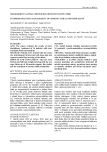External fixation in children
Authors:
Bronislav Hnilička; Vladimír Bartl; Štěpánka Bibrová
Authors‘ workplace:
Department of paediatric surgery, orthopaedics and traumatology, University hospital Brno
; Klinika dětské chirurgie, ortopedie a traumatologie FN Brno
Published in:
Úraz chir. 16., 2008, č.4
Overview
External fixation in children is indicated in specific cases. Apart from fractures, there are also other orthopaedic and traumatology indications. Among the advantages of this method are, similarly to the use in adult patients, a relatively quick application, stable fixation with desired minimal intrafragmental movement and protection of soft tissues. The authors of the review introduce specific indications for the use of external fixation, as well as the types of fixators used with children.
At The Department of Paediatric Surgery, Orthopaedics and Traumatology, University hospital Brno, there were 102 external fixations carried out in the last 7 years, 65 of these were due to corrective osteotomy, the remaining 37 due to traumatology indications. The corrective osteotomy deals with angular, as well as longitudal deformities. The most commonly observed is the posttraumatic or congenital deformity of the distal radius and femur. An inborn angular deformity is most common with the distal radius. The Ilizarov compression-distraction apparatus was the most frequently used device in the past, presently, we are turning to the use of internal fixators (LCPLocking Compression Plate). Similarly to adults, the external fixator presents the only corrective method in case of comminuted fractures.
However, the risk of infection in open fractures is very high, thus not enabling the use of standard procedures of miniinvasive osteosynthesis. That is why the presence of a open fracture is also a direct indication for external osteosynthesis. The external fixation is the most common and considerate method of osteosynthesis in paediatric fractures of the pelvis, and thus the method of first choice at our clinic. A specific indication for the use of external fixation in paediatric pelvic fractures is the extrophy of the bladder with disjunction of symphisis pubica.
To conclude, it is possibly to say that external fixation an inevitable part of the “tools” of a paediatric traumatologist, as it presents the only lege-artis means of treatment in specified indications.
Key words:
external fixation, fracture, osteotomy, child.
Sources
1. Gál, l., Nečas, a., Plánka, l., Kecová, h., Křen, l., Krupa, p., Hlučilová, l., Us-vald, d. Chondrocytic Potential of Allogenic Me-senchymal Stem Cells Transplanted without Immuno-suppression to Regenerate Physeal Defect in Rabbits. Acta Vet Brno. 2007, 76, 265–275.
2. Giannoni, P., Mastrogiacomo, M., Alini, M. et al. Regeneration of large bone defects in sheep using bone marrow stromal cells. J Tissue Eng Regen Med. 2008, 2(5), 253–262.
3. Janovec, M., Jochymek, J. Výsledky prodlou-žení femuru u 34 dětí. Acta Chir Orth Trauma. Čech. 1990, 57.
4. Jochymek, J., Gál, P. Evaluation of bone healing in rekurs lenghthened via gradual distraction Metod. Biomedical Papers. 2007, 151(1), 137–143.
5. Katolik, L.I., Stewart, M., Fernandez, J. et al. Biomechanical evaluation of 10 configurations of a small external fixator set. Am J Orthop. 2008, 37(9), 462–465.
6. POKORNÝ, V. Traumatologie. Praha: Triton, 2002. 307 s.
7. Planka, L., Gal, P., Kecova, H., Klima, J., Hlucilova, J., Filova, E., Amler, E., Kru-pa, P., Kren, L., Srnec, R., Urbanova, L., Lorenzova, J., Necas, A. Allogeneic and autogenous transplantations of MSCs in treatment of the physeal bone bridge in rabbits. BMC Biotechnol. 2008, 12, 70.
8. Plánka, L., Chalupová, P., Škvařil, J., Poul, J., Gál, P. Remodelling ability of the distal radius in fracture healing in childhood. Rozhl Chir. 2006, 85, 508–510.
9. Plánka, l., Nečas, a., Gál, p., Kecová, h., Filová, e., Křen, l., Krupa, p. Prevention of Bone Bridge Formation Using Transplantation of the Autogenous Mesenchymal Stem Cells to Physeal Defects: An Experimental Study in Rabbits. Acta Vet Brno. 2007, 76, 253–263.
10. Plánka, L., Poul, J., Gál, P. Massive spon-gioplasty and external fixation in the posttraumatic pseudoarthrosis management – a case review. Rozhl Chir. 2005, 84, 505–510.
11. Taller, S., Lukás, R., Srám, J., Krivo-hlávek, M. Urgent management of the complex pelvic fractures. Rozhl Chir. 2005, 84, 83–87.
12. Zeman, J., Matejka, J. Use of a hybrid external fixator for treatment of tibial fractures. Acta Chir Orthop Traumatol Cech. 2005, 72, 337–343.
Labels
Surgery Traumatology Trauma surgeryArticle was published in
Trauma Surgery

2008 Issue 4
Most read in this issue
- Flexor hallucis longus transfer for neglected and large Achilles tendon rupture
- External fixation in children
- Interdisciplinary management of chronic tibial osteomyelitis
- Therapeutic influence of colloids on extravascular lung water and oxygenation functions in patients with severe sepsis
